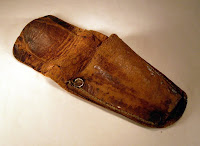A survival bracelet made from paracord (parachute cord) should be constructed so that it comes apart easily and gives you a sufficient length to use in your emergency.

I'll be looking at the 3 different styles you'll most likely find somewhere online: the single-strand solomon, the double-strand solomon, and the single-strand weave. ("Solomon" refers to a solomon bar which is a series of square knots. You can also look at a previous blog article I did on the solomon bar
HERE. And the weave is just going over-under-over, etc. then snugging it tight.)
I made the three bracelets for my wrist, about 7 1/4" around. But don't get hung up on the numbers. And I don't want to get too technical with all this. I'm just trying to give you something to think about.
First up is the double-strand solomon, the most popular but as you'll see, is the worst of all three styles for a survival bracelet.

Is it easy to take apart? A solomon bar (a series of square knots) is easy to undo because paracord square knotting doesn't stay tight. But each of those knots will have to be undone individually. So as you're standing there freezing, sweating or in the wind or rain, you'll be fumbling through each knot. Easy, but it'll take a few minutes.
Is there a suffficient length of cord to use? For mine, I used 2 strands of paracord about 50" each. So that's 100" but it's not really 100 because if you need that longer length you'll have to tie a "bend" to join the 2 strands together and that will reduce your total length by about 3 inches for each strand. And the reliability and strenth of that connection will be dependent on the type of bend you tie. But with any knot, it will be weaker than a single strand. So you've got a weak 94" - though that may be good enough for what you need to do.
Second, is the single-strand solomon.

It's comes apart and has about the same length as the double strand but you'll get one long piece of cord. For that reason alone, it's better in a survival situation than the double-strand. If you need two lengths, you can always cut it. You're carrying a knife, aren't you? (Though with the single-strand, you can cut it where you want. With the double-strand, you're stuck with where it's already been cut.)
Third, and I think, the best bracelet for your survival or emergency situation is the single-strand weave. I used about 115" to make mine (more paracord than either solomon) and it's one strand.

But is it easy to take apart?
Taking apart the weave, is like pulling on a loose thread... The way it's put together, it's just one pull and your bracelet (with a little help) will come apart. It's so much faster and easier than the solomons, they shouldn't even be compared to each other.
So, I believe, the weave is your best bracelet for survival.
But don't be so quick to throw out your solomon bar bracelets and jump on the Weave bandwagon till you see what else I've got to say on the subject.
I'm working on a Part 2 to look at the other things you should consider before buying or making your "survival" bracelet. Like should you get one with a buckle or a shackle?

Seems obvious? Don't be so sure.
For now though, you can check out Stormdrane's tutorial on making the weave bracelet HERE. It's what I used to make mine. I'm not really sure anyone sells a "weave" bracelet, most are the square-knotted type - Google "paracord bracelet" to find those.
And if you need to tie your two strands of paracord together, use a "bend" that won't come apart in a couple shakes (like the sheet bend). Try the far-superior Zeppelin Bend HERE.
(This was adapted from a post I made on the Every Day Carry Forums.)

Mountain House Freeze-Dried Food

 For the longest time I didn't have a snap for the handle strap and I didn't like the way the sheath would flop around while hanging from my belt. So I added a boot lace to the sheath - I could tie it down to my leg and when I took my knife off, I would loop the boot lace around the knife guard then tie a couple half-hitches to hold it down so the knife wouldn't slide out of the sheath.
For the longest time I didn't have a snap for the handle strap and I didn't like the way the sheath would flop around while hanging from my belt. So I added a boot lace to the sheath - I could tie it down to my leg and when I took my knife off, I would loop the boot lace around the knife guard then tie a couple half-hitches to hold it down so the knife wouldn't slide out of the sheath.






















































